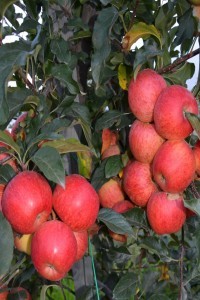Efficacy of a pilot-scale ultrasonication system for pasteurization of milk
Efficacy of a pilot-scale ultrasonication system for pasteurization of milk
This study aimed to test a pilot-scale continuous ultrasonication (US) system to pasteurize whole milk in terms of physical properties, energy consumption, and inactivation of alkaline phosphatase (ALP), total mesophilic aerobic bacteria (TMAB), total coliform (TC), total enterobactericeae (TE), and Escherichia coli. Except for those treated by 90% amplitude for 20 and 30 min, the samples were found negative for ALP activity. Inactivation of TC, TMAB, TE, and E. coli rose with an increased amplitude and temperature. The maximum cost was estimated at 2.778,00 € for the system and at 3.624,00 € for plate heat exchanger to pasteurize 20.000 L of milk. 96.52% amplitude, 40 min, and 53.50 °C were determined jointly as the optimal operational settings.
___
- Asaithambi, N., Singha, P., Dwivedi, M., & Singh, S. K. (2019). Hydrodynamic cavitation and its application in food and beverage industry: A review. Journal of Food Process Engineering, 42(5), e13144. https://doi.org/10.1111/jfpe.13144
- Ashokkumar, M., Bhaskaracharya, R., Kentish, S., Lee, J., Palmer, M., & Zisu, B. (2010). The ultrasonic processing of dairy products—An overview. Dairy Science & Technology, 90(2), 147–168. https://doi.org/10.1051/dst/2009044
- Bermúdez-Aguirre, D., Mobbs, T., & Barbosa-Cánovas, G. V. (2011). Ultrasound Applications in Food Processing. In H. Feng, G. Barbosa-Canovas, & J. Weiss (Eds.), Ultrasound Technologies for Food and Bioprocessing (pp. 65–105). Springer. https://doi.org/10.1007/978-1-4419-7472-3_3
- Cameron, M., McMaster, L. D., & Britz, T. J. (2010). Impact of ultrasound on dairy spoilage microbes and milk components. Dairy Science & Technology, 90(1), 119–119. https://doi.org/10.1051/dst/2010003
- Carpenter, J., Badve, M., Rajoriya, S., George, S., Saharan, V., & Pandit, A. (2016). Hydrodynamic cavitation: An emerging technology for the intensification of various chemical and physical processes in a chemical process industry. Reviews in Chemical Engineering, 33. https://doi.org/10.1515/revce-2016-0032
- Chandrapala, J., Martin, G. J. O., Zisu, B., Kentish, S. E., & Ashokkumar, M. (2012). The effect of ultrasound on casein micelle integrity. Journal of Dairy Science, 95(12), 6882–6890. https://doi.org/10.3168/jds.2012-5318
- Chemat, F., Zill-e-Huma, & Khan, M. K. (2011). Applications of ultrasound in food technology: Processing, preservation and extraction. Ultrasonics Sonochemistry, 18(4), 813–835. https://doi.org/10.1016/j.ultsonch.2010.11.023
- Chouliara, E., Georgogianni, K. G., Kanellopoulou, N., & Kontominas, M. G. (2010). Effect of ultrasonication on microbiological, chemical and sensory properties of raw, thermized and pasteurized milk. International Dairy Journal, 20(5), 307–313. https://doi.org/10.1016/j.idairyj.2009.12.006
- De Jong, P., & Villamiel, M. (2000). Inactivation of Pseudomonas flourescens and Streptococcus thermophilus in trypticase soy broth and total bacteria count in milk by continuous-flow ultrasonic treatment and conventional heating. Journal of Food Engineering, 45, 171–179. https://doi.org/10.1016/S0260-8774(00)00059-5
- Ganesan, B., Martini, S., Solorio, J., & Walsh, M. K. (2015). Determining the effects of high intensity ultrasound on the reduction of microbes in milk and orange juice using response surface methodology. International Journal of Food Science, 2015, 1–7. https://doi.org/10.1155/2015/350719
- Gogate, P., & Pandit, A. (2001). Hydrodynamic cavitation reactors: A state of the art review. Reviews in Chemical Engineering, 17, 1–85. https://doi.org/10.1515/REVCE.2001.17.1.1
- Griffiths, M. W. (1986). Use of milk enzymes as indices of heat treatment. Journal of Food Protection, 49(9), 696–705. https://doi.org/10.4315/0362-028X-49.9.696
- Martini, S. (2013). Common Uses of Power Ultrasound in the Food Industry. In S. Martini (Ed.), Sonocrystallization of Fats (pp. 27–33). Springer. https://doi.org/10.1007/978-1-4614-7693-1_4
- McSweeney, P. L. H., & Fox, P. F. (2009). Significance of Lactose in Dairy Products. In P. McSweeney & P. F. Fox (Eds.), Advanced Dairy Chemistry: Volume 3: Lactose, Water, Salts and Minor Constituents (pp. 35–104). Springer. https://doi.org/10.1007/978-0-387-84865-5_3
- Milly, P. J., Toledo, R. T., Kerr, W., & Armstead, D. (2008). Hydrodynamic cavitation: characterization of a novel design with energy considerations for the ınactivation of Saccharomyces cerevisiae in apple juice. Journal of Food Science, 73, M298-303. https://doi.org/10.1111/j.1750-3841.2008.00827.x
- Milly, P., Toledo, R., Harrison, M., & Armstead, D. (2007). Inactivation of food spoilage microorganisms by hydrodynamic cavitation to achieve pasteurization and sterilization of fluid foods. Journal of Food Science, 72, M414-22. https://doi.org/10.1111/j.1750-3841.2007.00543.x
- Munir, M., Nadeem, M., Qureshi, T. M., Leong, T. S. H., Gamlath, C. J., Martin, G. J. O., & Ashokkumar, M. (2019). Effects of high pressure, microwave and ultrasound processing on proteins and enzyme activity in dairy systems—A review. Innovative Food Science and Emerging Technologies, 57.
- Nguyen, N. H. A., & Anema, S. G. (2017). Ultrasonication of reconstituted whole milk and its effect on acid gelation. Food Chemistry, 217, 593–601. https://doi.org/10.1016/j.foodchem.2016.08.117
- Pegu, K., & Arya, S. S. (2021). Comparative assessment of HTST, hydrodynamic cavitation and ultrasonication on physico-chemical properties, microstructure, microbial and enzyme inactivation of raw milk. Innovative Food Science & Emerging Technologies, 69, 102640. https://doi.org/10.1016/j.ifset.2021.102640
- Prasantha, B. D. R., & Wimalasiri, K. M. S. (2019). Effect of HTST thermal treatments on end-use quality characteristics of goat milk. International Journal of Food Science, 2019, 1801724. https://doi.org/10.1155/2019/1801724
- Salve, A. R., Pegu, K., & Arya, S. S. (2019). Comparative assessment of high-intensity ultrasound and hydrodynamic cavitation processing on physico-chemical properties and microbial inactivation of peanut milk. Ultrasonics Sonochemistry, 59, 104728. https://doi.org/10.1016/j.ultsonch.2019.104728
- Shamsi, K., Versteeg, C., Sherkat, F., & Wan, J. (2008). Alkaline phosphatase and microbial inactivation by pulsed electric field in bovine milk. Innovative Food Science & Emerging Technologies, 9, 217–223. https://doi.org/10.1016/j.ifset.2007.06.012
- Tao, N., Liu, Y., & Zhang, M. (2009). Chemical composition and antimicrobial activities of essential oil from the peel of bingtang sweet orange (Citrus sinensis Osbeck). International Journal of Food Science & Technology, 44, 1281–1285. https://doi.org/10.1111/j.1365-2621.2009.01947.x
- Yayın Aralığı: Yılda 2 Sayı
- Başlangıç: 2019
- Yayıncı: Burhan ÖZTÜRK
Sayıdaki Diğer Makaleler
Effect of polyethylene plastic mulch on yield and fruit quality parameters of tomato
Burak TUZEN, Aslıhan ÇİLİNGİR TÜTÜNCÜ, Salim TASDELEN, Aysun PEKŞEN
Hassan ADAMU, Luka Fitto BUBA, Nura Isyaku BELLO, Hamza Ahmad ISIYAKA, Muhammad ALHAJI, Tijjani Abdullahi YAHAYA
Postharvest losses in food grains – A Review
Nura ABDULLAHİ, Munir Abba DANDAGO
Efficacy of a pilot-scale ultrasonication system for pasteurization of milk
Gülsün AKDEMİR EVRENDİLEK, Anıl BODRUK, Furkan ACAR
Rooting of black elderberry (Sambucus nigra L.) by treating of indole-3-acetic acid
Nazlıcan SÖNMEZIŞIK, Şahane Funda ARSLANOĞLU, Rumeysa ÖZTÜRK, Mehmet Han BAŞTÜRK
